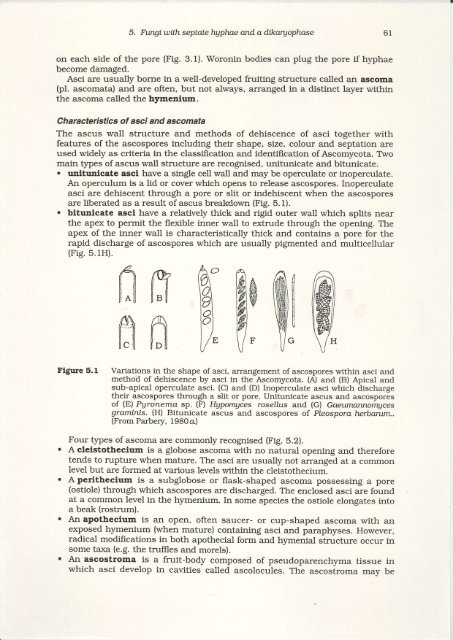Fungi with septate hyphae and a dikaryophase
Fungi with septate hyphae and a dikaryophase
Fungi with septate hyphae and a dikaryophase
You also want an ePaper? Increase the reach of your titles
YUMPU automatically turns print PDFs into web optimized ePapers that Google loves.
5. htngituith <strong>septate</strong> hgphae <strong>and</strong> a dikatyophase<br />
on each side of the pore (Fig. 3.1). Woronin bodies can plug the pore if <strong>hyphae</strong><br />
become damaged.<br />
Asci are usually borne in a well-developed fruiting structure called an ascoma<br />
(pl. ascomata) <strong>and</strong> are often, but not always, arranged in a distinct layer <strong>with</strong>in<br />
the ascoma called the hymenium.<br />
Characteristics of asci <strong>and</strong> ascomata<br />
The ascus wall structure <strong>and</strong> methods of dehiscence of asci together <strong>with</strong><br />
features of the ascospores including their shape, size, colour <strong>and</strong> septation are<br />
used widely as criteria in the classilication <strong>and</strong> identification of Ascomycota. TWo<br />
main types of ascus wall structure are recognised, unitunicate <strong>and</strong> bitunicate.<br />
o unitunicate asci have a single cell wall <strong>and</strong> may be operculate or inoperculate.<br />
An operculum is a lid or cover which opens to release ascospores. Inoperculate<br />
asci are dehiscent through a pore or slit or indehiscent when the ascospores<br />
are liberated as a result of ascus breakdown (Fig. 5.1).<br />
. bitunicate asci have a relatively thick <strong>and</strong> rigid outer wall which splits near<br />
the apex to permit the flexible inner wall to extrude through the opening. The<br />
apex of the inner wall is characteristically thick <strong>and</strong> contains a. pore for the<br />
rapid discharge of ascospores which are usually pigmented <strong>and</strong> multicellular<br />
(Fig. 5.IH).<br />
ffi/T\<br />
A<br />
u"{<br />
M<br />
Iit<br />
Inll<br />
nI t i l<br />
foll<br />
&<br />
wr @\/" U"<br />
Fig;ure 5.1 Variations in the shape of asci, arrangement of ascospores <strong>with</strong>in asci <strong>and</strong><br />
method of dehiscence by asci in the Ascomycota. (A) <strong>and</strong> (B) Apical <strong>and</strong><br />
sub-apical operculate asci. (C) <strong>and</strong> (D) Inoperculate asci which discharge<br />
their ascospores through a slit or pore. Unitunicate ascus <strong>and</strong> ascospores<br />
of (E) Pgronema sp. (F) Hgpomyces rosellus <strong>and</strong> (G) GaeumqnnomAces<br />
graminis. (H) Bitunicate ascus <strong>and</strong> ascospores of Pleospora herbarum..<br />
(From Parbery, 1980cr.)<br />
Four types of ascoma are commonly recognised (Fig. b.2).<br />
' A cleistothecium is a globose ascoma <strong>with</strong> no natural opening <strong>and</strong> therefore<br />
tends to rupture when mature. The asci are usually not arranged at a corunon<br />
level but are formed at various levels <strong>with</strong>in the cleistothecium.<br />
' A Perithecium is a subglobose or flask-shaped ascoma possessing a pore<br />
(ostiole) through which ascospores are discharged. The enclosed asci are found<br />
at a common level in the hymenium. In some species the ostiole elongates into<br />
a beak (rostrum).<br />
. An apothecium is an open, often saucer- or cup-shaped ascoma <strong>with</strong> an<br />
exposed hymenium (when mature) containing asci <strong>and</strong> paraphyses. However,<br />
radical modifications in both apothecial form <strong>and</strong> hymenial structure occur in<br />
some taxa (e.g. the truffles <strong>and</strong> morels).<br />
' An ascostroma is a fruit-body composed of pseudoparenchyma tissue in<br />
which asci develop in cavities called ascolocules. The ascostroma mav be<br />
6I







![[Compatibility Mode].pdf](https://img.yumpu.com/27318716/1/190x135/compatibility-modepdf.jpg?quality=85)









